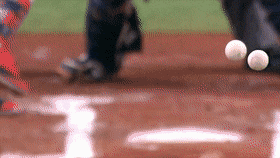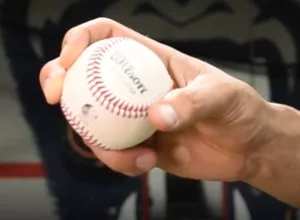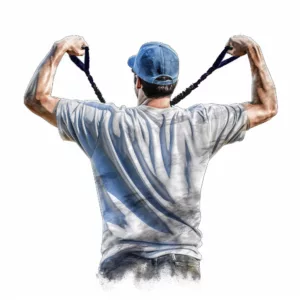 Are you ready to learn how to throw the perfect curveball without placing undue pressure on your arm? Welcome to "How to Throw a Curveball Without Hurting Your Arm," where we'll explain the secrets of this elusive pitch while also assisting you in preserving the health of your arm. A well-executed curveball may be a game-changer in baseball, leaving batters perplexed and swinging at air. Curveballs thrown incorrectly, on the other hand, can cause damage and have a severe impact on a player's career. As a result, mastering good mechanics and tactics is critical for any aspiring pitcher.
Are you ready to learn how to throw the perfect curveball without placing undue pressure on your arm? Welcome to "How to Throw a Curveball Without Hurting Your Arm," where we'll explain the secrets of this elusive pitch while also assisting you in preserving the health of your arm. A well-executed curveball may be a game-changer in baseball, leaving batters perplexed and swinging at air. Curveballs thrown incorrectly, on the other hand, can cause damage and have a severe impact on a player's career. As a result, mastering good mechanics and tactics is critical for any aspiring pitcher.
In the next sections, we'll look at the science underlying a curveball's trajectory, the role of grip and arm motion, and injury prevention through appropriate technique and conditioning. We'll also provide you advice from professional pitchers and coaches to help you refine your talents and keep your arm in top shape. So, whether you're a beginner pitcher or an experienced athlete trying to improve your talents, this article will be a great resource on your quest to perfecting the curveball while prioritizing the health and longevity of your arm.
Here are some key takeaways from this article on How to Throw a Curveball Without Hurting Your Arm:
- The curveball's distinctive movement is due to the Magnus effect, which causes the ball to break downward and sideways.
- Proper grip and arm motion techniques are essential for generating the desired spin and trajectory of a curveball.
- The release point and speed of a curveball play crucial roles in maximizing the pitch's effectiveness.
- Injury prevention and arm conditioning are vital for a pitcher's career, ensuring long-term health and performance.
- The 3X Pitching Velocity Program is a comprehensive training regimen that focuses on functional strength, power, flexibility, and improved biomechanics to reduce the risk of injury.
- It's essential to start developing proper mechanics and incorporating a well-rounded training program to master the curveball and protect the arm from injury.
Understanding the Physics to Throw a Curveball
 The first step in mastering the curveball is grasping the underlying physics that dictate its distinctive movement. The curveball is a breaking pitch, meaning it deviates from a straight path due to the Magnus effect, which occurs when a spinning object, like a baseball, travels through the air. The Magnus effect is the result of differences in air pressure created by the ball's rotation, causing it to curve in a specific direction. For a curveball, the spin axis is usually tilted towards the pitcher's glove side, which creates a downward and sideways movement.
The first step in mastering the curveball is grasping the underlying physics that dictate its distinctive movement. The curveball is a breaking pitch, meaning it deviates from a straight path due to the Magnus effect, which occurs when a spinning object, like a baseball, travels through the air. The Magnus effect is the result of differences in air pressure created by the ball's rotation, causing it to curve in a specific direction. For a curveball, the spin axis is usually tilted towards the pitcher's glove side, which creates a downward and sideways movement.
The spin rate, or the number of revolutions per minute (RPM) a ball completes during its flight, plays a crucial role in the efficacy of a curveball. A higher spin rate increases the Magnus effect, causing the ball to break more sharply and making it more difficult for batters to make contact. The seams of the baseball also contribute to the spin rate, as the raised seams cause the ball to grip the air, generating more movement.
An essential aspect of throwing an effective curveball is the release point. The release point is when the pitcher lets go of the ball, and it determines the trajectory of the pitch. To maximize the downward movement of a curveball, pitchers should release the ball with their fingers on top of the ball and their wrist in a slightly flexed position. This technique ensures the proper spin axis, which in turn generates the desired downward and sideways break.
The speed of a curveball also plays a role in its success. Generally, a curveball is thrown slower than a fastball to accentuate the movement created by the Magnus effect. The slower speed creates a more significant difference in air pressure around the ball, resulting in a more pronounced break. However, it is essential not to slow down the arm speed too much, as doing so can tip off the batter that a breaking pitch is coming. Balancing speed and movement is key to keeping the batter guessing and making the curveball a formidable weapon in a pitcher's arsenal.
Mastering the Grip and Arm Motion On How to Throw a Curveball
 The grip is critical in achieving the appropriate spin and trajectory when throwing a curveball. In the traditional curveball grip, the middle finger is placed along the seam where the two curved seams meet, forming a horseshoe shape. The index finger should be placed close to the middle finger, with the thumb gripping the opposite seam on the ball's underside. This grip provides maximal leverage on the release, producing the spin required for a sharp break. Maintaining a relaxed grip and avoiding excessive pressure will provide you more control and lower your chance of injury.
The grip is critical in achieving the appropriate spin and trajectory when throwing a curveball. In the traditional curveball grip, the middle finger is placed along the seam where the two curved seams meet, forming a horseshoe shape. The index finger should be placed close to the middle finger, with the thumb gripping the opposite seam on the ball's underside. This grip provides maximal leverage on the release, producing the spin required for a sharp break. Maintaining a relaxed grip and avoiding excessive pressure will provide you more control and lower your chance of injury.
It is ideal when throwing a curveball that you use the same mechanics as your fastball. The only difference is in the grip of the pitch and how you finish your arm action. During the release, the pitcher should concentrate on the "karate chop" motion, in which the pitcher's wrist and fingers go downward as the ball is released. This movement gives the required topspin to the ball, resulting in the optimum spin axis for the Magnus effect to occur. The fingers play a key role in the release because they generate the spin, while the wrist and forearm follow through to maintain good mechanics and control.
Practice is vital in perfecting the grip and arm motion skills for throwing a curveball, as it is with any ability. Begin by throwing the pitch a lower distance and progressively increasing the distance as you gain confidence in the mechanics. Working with a qualified coach or using video analysis can provide vital feedback, highlighting areas for growth, and assuring perfect technique. Patience and persistence are essential, since even veteran pitchers might spend months or even years perfecting their curveball.
Injury Prevention and Arm Conditioning for Pitchers
 Injury prevention is critical for pitchers since poor technique or overuse can result in severe arm injuries such as strains, sprains, and rips in muscles, ligaments, and tendons. Understanding appropriate mechanics and performing particular arm conditioning workouts can dramatically lessen the chance of injury while enhancing overall curveball performance. The 3X Pitching Velocity Program is one program aimed to improve pitching performance while reducing the risk of injury.
Injury prevention is critical for pitchers since poor technique or overuse can result in severe arm injuries such as strains, sprains, and rips in muscles, ligaments, and tendons. Understanding appropriate mechanics and performing particular arm conditioning workouts can dramatically lessen the chance of injury while enhancing overall curveball performance. The 3X Pitching Velocity Program is one program aimed to improve pitching performance while reducing the risk of injury.
The 3X Pitching Velocity Program is a thorough training regimen that focuses on developing functional strength, power, and flexibility while also enhancing a pitcher's biomechanics to increase efficiency and reduce injury risk. To develop and maintain a healthy arm, the program incorporates weightlifting, plyometric exercises, mobility drills, and specialized pitching drills. The 3X Pitching Velocity Program helps pitchers throw harder and more effectively without jeopardizing their long-term health by emphasizing optimal mechanics and functional strength.
The emphasis on lower body strength and power development is a vital component of the 3X Pitching Velocity Program. A strong lower body is required to generate the necessary force to throw a curveball without putting unnecessary strain on the arm. Squats, lunges, and box jumps can assist increase lower body strength, resulting in more efficient pitching mechanics and less stress on the arm. Pitchers can take use of the entire kinetic chain by focusing on the lower body, producing force from the ground up and limiting reliance on the arm alone.
The 3X Pitching Velocity Program promotes mobility and flexibility in addition to strength and power development. Pitchers must have a wide range of motion in their shoulders, elbows, and wrists in order to throw a curveball without risking injury. Exercises that increase shoulder stability, including as scapular retraction drills and rotator cuff strengthening, can help prevent pitching-related shoulder injuries. Wrist and forearm flexibility exercises, on the other hand, can improve a pitcher's ability to generate spin on the ball while reducing the risk of injury. Pitchers can increase their effectiveness on the mound while also protecting their arm health for years to come by implementing the 3X Pitching Velocity Program into their training routine.
Get Started Training to Throw a Curveball Without Hurting Your Arm
 Don't put off investing in the longevity of your pitching career any longer! Begin working on the mechanics that will help you avoid injury when throwing a curveball and reach your full ability on the mound. Begin by studying and practicing proper grip, arm motion, and release methods, with an emphasis on efficiency and consistency. Incorporate a thorough training program, such as the 3X Pitching Velocity Program, to improve your functional strength, power, and flexibility while also refining your pitching biomechanics.
Don't put off investing in the longevity of your pitching career any longer! Begin working on the mechanics that will help you avoid injury when throwing a curveball and reach your full ability on the mound. Begin by studying and practicing proper grip, arm motion, and release methods, with an emphasis on efficiency and consistency. Incorporate a thorough training program, such as the 3X Pitching Velocity Program, to improve your functional strength, power, and flexibility while also refining your pitching biomechanics.
Accept the opportunity to improve your game, stun batters with your curveball, and protect your arm health for years to come. Remember that patience, tenacity, and dedication to mastering the art of the curveball are the keys to success. So, take the first step today and begin your journey to being the pitcher you've always wanted to be. The time has come to begin throwing curveballs with confidence and precision while safeguarding your most precious asset: your arm.


